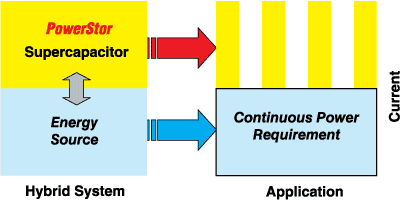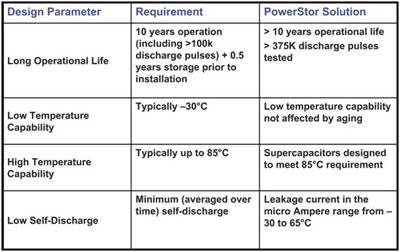Supercaps handle peak power for meter readers
As their mode of operation changes, mobile devices require more peak power than is available from their batteries
BY TRINA NOOR
Cooper Bussmann, Boca Raton, FL
www.cooperbussmann.com
Automatic meter reader (AMR) systems provide secure two-way communications and are the most adaptable metering systems available in today’s growing energy market. AMR systems gather real-time data and transfer this information to the central database through networking technology. An AMR unit produces accurate customer billing and provides customers with information such as power outages, wiring stability, and self diagnostics (see Fig. 1 ).

Fig. 1. AMR systems gather real-time data and transfer this information to the central database through networking technology. Electricity meters tap into line current for power, but need back-up power from supercapacitors. Gas and water meters require battery power. But batteries struggle to deliver power at cold temperatures and age with high temperatures unless aided by a supercapacitor.
Water and gas meters
Modern wireless meters require a power supply that can effectively run internal components at a constant rate and also handle the peak power demanded by the unit’s wireless transmitter (see Fig. 2 ). This kind of power demand reduces the life of most batteries.

Fig. 2. Peak power demands dramatically reduce the life of batteries that operate at extreme temperatures, as well as diminish operating performance. Supercapacitors help batteries deliver the required power over a broad operating temperature range of 40 to 85C.
Many battery-powered devices have power needs that can peak much higher than the battery’s capacity as their mode of operation changes. Some need high-current pulse power that may be difficult or impossible for batteries to supply without increasing the risk of performance failures, reduced operational life, or even premature battery failures. Batteries have a limited cycle life due to aging of their chemical energy storage mechanism. In contrast supercapacitors offer an electrostatic energy storage mechanism and have no wear-out allowing practically infinite cycle life.
Another problem with conventional batteries is the high internal equivalent series resistance (ESR) that prevents them from consistently delivering high-power pulses. By comparison, supercapacitors have very low internal ESR that allows them to deliver high-power pulses.
Not surprisingly, the supercapacitors that made their way into many consumer products are now also helping automated water and gas meters operate longer. Supercapacitors offer a solution for supplementing and increasing battery life by fulfilling peak power demands in AMR applications. In these applications, the supercapacitor is charged from the primary power supply but functions as a backup power source when the primary source fails or peak power has to be provided. Supercapacitors work in parallel with batteries for applications that require both a constant low power discharge for continual function and a pulse power for peak loads.
It is well known that adding capacitors in parallel with the source battery can help supply power during pulses due to the relatively low ESR of capacitors. Placing a low-ESR supercapacitor in parallel with a battery can easily meet the demands for almost any required pulse current (see Fig. 3 ). Energy is delivered slowly from the parallel, higher ESR battery to charge the supercapacitor and then delivered from the supercapacitor with a sudden burst of current when needed. After delivering the pulse current, the supercapacitor will again recharge to the battery’s full voltage during the time between the pulsed load cycles. This reduces the stress on the battery and extends the overall life of the battery by a factor of three or more, when compared to not having the supercapacitor in the circuit.

Fig. 3. Supercapacitors provide solutions for multiple AMR design objectives.
In addition to benefitting peak current demand performance, supercapacitors also solve another big challenge designers of battery-powered AMR circuits encounter due to voltage drop in their system designs. Too large a voltage change will cause the internal layer of a lithium battery to breakdown, leading to higher leakage currents that result in a much shortened battery life. In addition to satisfying peak power demands, supercapacitors prevent large voltage swings by maintaining a fully charged state to act as a power reserve or to perform critical functions in the event of power loss.
A further consideration for AMR applications is the ability to operate over the widest operating temperature range of 40 to 85C or even higher. These temperature extremes severely reduce the operating performance of batteries and can cause degradation in battery life as well. In the case of low ambient temperatures, the internal resistance of the battery increases dramatically. The stand-alone battery may not have enough power for the transmitter and, in turn, leads to a shortened battery life.

Fig. 4. Cooper Bussmann PM-series and M-series supercapacitors.
The PM-Series and M-Series supercapacitors (see Fig. 4 ) from the Cooper Bussmann PowerStor brand are designed for use in AMR water and gas applications. These devices feature a wide operating temperature range with very low resistance to meet the tough environmental demands of this type meter.
Electricity meters
Electricity meters typically draw power from the input power line, but AMR circuits need to remain powered to retain information during primary power outages. Transmitter power is usually not required during the power outage so a battery is not necessary. A large value supercapacitor can be used to power the system for hours or days until line power is restored. Of course a battery could be used to provide this power, but as discussed previously batteries have limited cycle life and encounter problems operating over a wide enough operating temperature range, so supecapacitors are usually the best temporary power solution.
Although the larger capacitance of the M-Series and PM-Series supercapacitors can operate electricity meters for very long periods, the KR-Series of coin cell supercapacitors from Cooper Bussmann are the choice for many electricity meter installations. The coin cell product has a higher ESR and lower capacitance, but because transmitter power is normally not required during a line power outage these devices have enough energy storage and low enough ESR to power the electricity meter for hours or days until line power is restored. ■
| Design Parameter | Requirement | PowerStor Solutions |
| Long operational life | 10 years operation (including >100k discharge pulses) + 0.5 years storage prior to installation | > 10 years operational life> 375K discharge pulses tested |
| Low-temperature capability | Typically –40°C | Low temperature capability not affected by aging |
| High-temperature capability | Typically up to 85°C | Supercapacitors designed to meet 85°C requirement |
| Low self-discharge | Minimum (averaged over time) self-discharge | Leakage current in the micro Ampere range from –30 to 65°C |
Advertisement
Learn more about Cooper Bussmann





